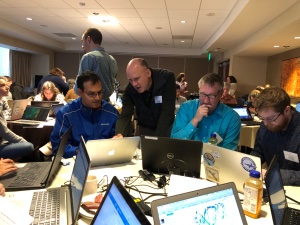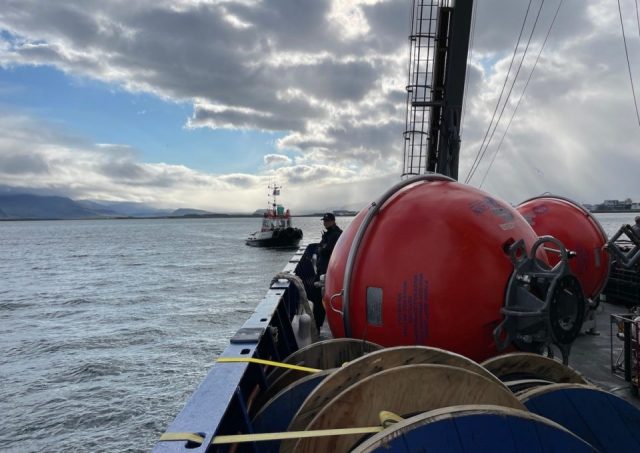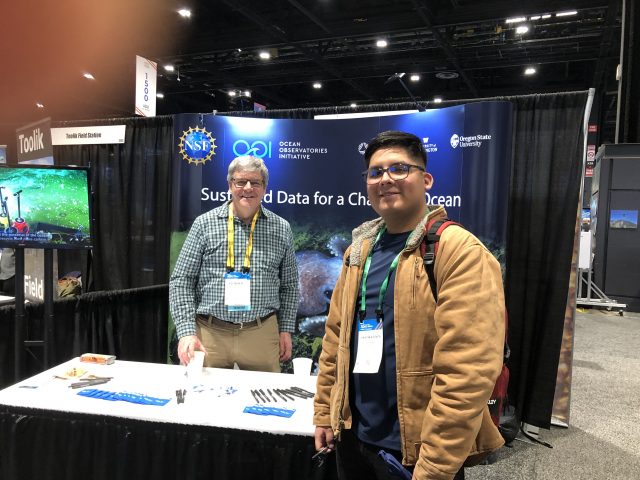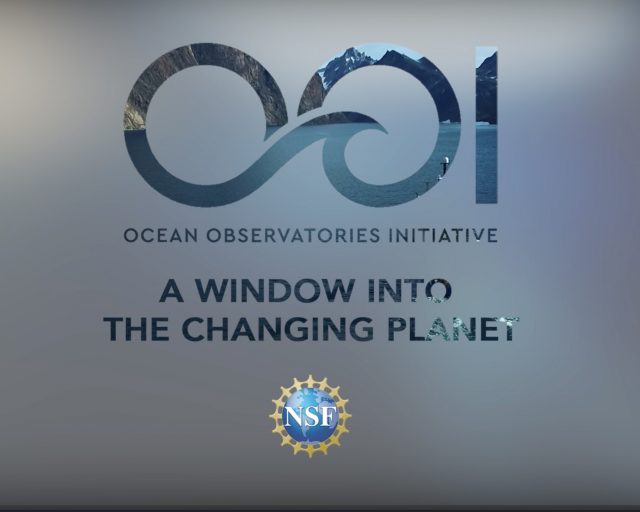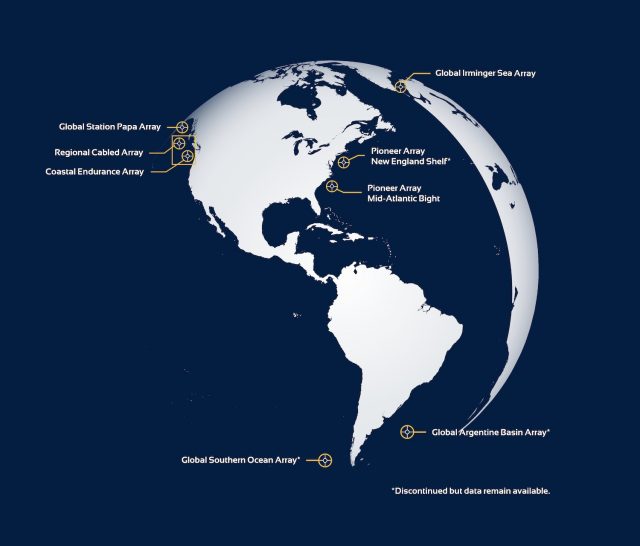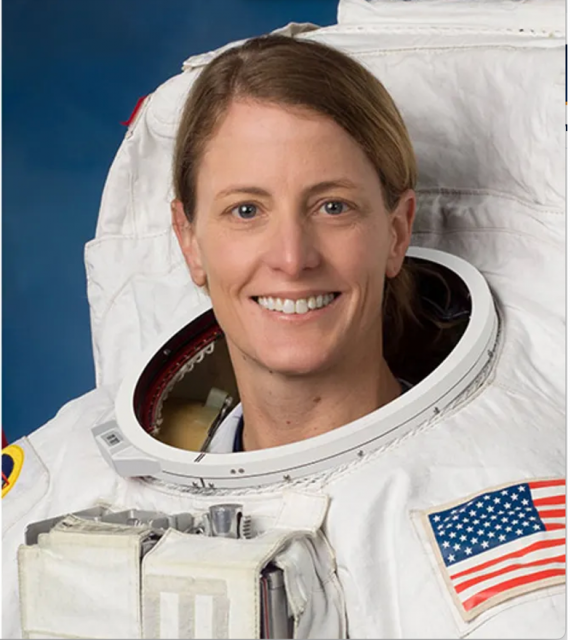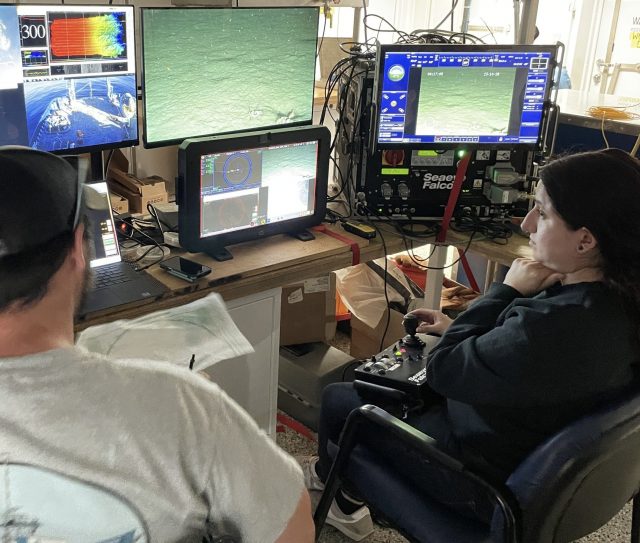News
Ocean Data Labs Mini-Workshop at OSM24
On Wednesday, February 21st, the Ocean Data Labs will host a “mini” workshop for professors interested in learning about the Ocean Observatories Initiative (OOI) and how they can utilize OOI data to support the teaching of oceanographic concepts and data literacy to undergraduate students.
The workshop will introduce faculty to the community-developed collection of OOI Data Explorations and the online OOI Lab Manual. Participants will learn how these resources can be integrated into introductory oceanography (or similar) courses to support student learning.
This OOI Data Labs workshop will be held from 10:30am to 3:30pm, in a hotel next to the New Orleans Convention Center, making it easy for attendees to participate in both the workshop and the meeting. OSM registration is not required to attend the workshop. Space is limited, so please apply early.
For more information and to apply, please visit 2024 OOI Data Labs Workshop page.
Read MoreCall for Additional Ocean Observations
In a widely distributed editorial opinion piece, Peter de Menocal, president and director of the Woods Hole Oceanographic Institution, and Margaret Leinen, vice chancellor for marine science and director of the Scripps Institution of Oceanography/University of California San Diego, explain why the ocean can be seen as our greatest ally in tackling climate change. They cite the importance of ocean observing systems like the Ocean Observatories Initiative (OOI), the ARGO Program, and ship-based operations, including those supported by the global GO-SHIP expeditions.
Read about how OOI and others are contributing vital data to understanding the changing ocean.
https://oceanographicmagazine.com/features/the-ocean-our-greatest-ally-in-tackling-climate-change/
http://digital.oceannews.com/december-2023/page-1?m=9767&i=810338&p=14&_ga=2.249360967.1538107420.1702656208-1663532955.1702656207&ver=html5
Read More
OOI at AGU 2023
[media-caption path="/wp-content/uploads/2023/10/IMG_1078-scaled.jpg" link="#"]OOI at booth #220 in the exhibit hall at AGU this year. Stop by and say hello! [/media-caption]
OOI will be at booth #220 at the AGU Fall Meeting 2023 in San Francisco from December 12-16. The following is a compilation of OOI-related presentations at this year’s fall meeting. If we’ve missed any OOI-related sessions, please contact dtrewcrist@whoi.edu and we will be happy to add them. Hope to see you in person this year! Share your AGU news at #AGU23.
Monday, 11 December 2023
14:10- 18:30 PST(17:10 – 21:30 EDT) Poster Hall A-C – South (Exhibition Level, South, Moscone Center)
Board 0501: Analyzing the Magnetic Signals of Tsunami Waves Using a Long-Term Seafloor Magnetometer Observatory
Neesha R Schnepf, Laboratory for Atmospheric and Space Physics, Christine J Chesley, Lamont-Doherty Earth Observatory, Deborah S Kelley, University of Washington, Dana Manalang, University of Washington, Applied Physics Laboratory, Hiroaki Toh, Kyoto University, Takuto Minami, Kobe University, and Manoj C Nair, University of Colorado, Boulder, United States
16:20- 16:30 PST(19:20 – 19:30 EDT) 153 – South (Upper Mezzanine, South, Moscone Center)
V14B-03 – Characterizing seismic and acoustic signals at Axial Seamount with unsupervised machine learning
Kaiwen Wang, Lamont-Doherty Earth Observatory, Columbia University; Felix Waldhauser, Columbia University; Maya Tolstoy, University of Washington, William S D Wilcock, University of Washington, Theresa Sawi, Lamont-Doherty Earth Observatory, Columbia University; David Paul Schaff, Lamont-Doherty Earth Observatory, Columbia University; and Yen Joe Tan, The Chinese University of Hong Kong
15:00-18:00 CST Exhibit Hall – Visit OOI’s Booth #220
Wednesday, 13 December 2023
16:45 – 16:55 PST (19:45 – 19:55 EDT) 153 – South (Upper Mezzanine, South, Moscone Center)
V34B-05 – Dynamic magma movements beneath the Axial Seamount revealed a new eruption precursor
Youyi Ruan, Nanjing University, School of Earth Science and Engineering; Li Wang, Nanjing University, School of Earth Science and Engineering and Qin Wang, School of Earth Sciences and Engineering, Nanjing University
14:10 – 18:30 PST (17:10 – 21:30 EDT) Poster Hall A-C – South (Exhibition Level, South, Moscone Center)
Board 1602: A Total Water Level Model Testbed on the US West Coast
David Honegger, Oregon State University, Carter Howe, Oregon State University, Jay Merrill, Oregon State University, Carson WilliamsOregon State University, David Hill Oregon State University, Merrick C Haller, Oregon State University,and Peter Ruggiero, Oregon State University,
10:00-18:00 CST Exhibit Hall – Visit OOI’s Booth #220
Thursday, 14 December 2023
08:39 – 08:42 PST (11:39 – 11:42 EDT) eLightning Theater V, Hall D – South (Exhibition Level, South, Moscone Center)
V41G-04 – Is Axial Seamount just napping? An update on the latest inflation and seismic data
William W. Chadwick Jr, Oregon State University, William S D Wilcock, University of Washington, Scott L Nooner, University of North Carolina at Wilmington, and Jeffrey W Beeson, Oregon State University
11:12 – 11:22 PST (14:12 – 14:22 EDT) 158 – South (Upper Mezzanine, South, Moscone Center)
G42A-06 – An Acoustic Array at Axial Seamount for Geodesy and Autonomous Vehicle Support
Maleen Kidiwela, University of Washington, School of Oceanography, Dana Manalang, Applied Physics Laboratory, University of Washington, William S D Wilcock, School of Oceanography, University of Washington, and Jake Ploskey, Applied Physics Laboratory, University of Washington
14:10 – 18:30 PST (17:10- – 21:30 EDT) 158 – Poster Hall A-C – South (Exhibition Level, South, MC)
OS43D-1823 Investigations of Air-Sea Interaction Using Surface Flux and Wave Data from the Ocean Observatories Initiative (OOI)
James B. Edson, Woods Hole Oceanographic Institution, Douglas C Vandemark, University of New Hampshire, and Marc Emond, University of New Hampshire
10:00-18:00 CST Exhibit Hall – Visit OOI’s Booth #220
Friday, 15 December 2023
08:30 – 12:50 PST (11:30 – 15:50 EDT) Poster Hall A-C – South (Exhibition Level, South, Moscone Center)
Board 0595: MonitorMyOcean.com: Transforming Research into an Interactive Web Application to Raise Awareness on Ocean Noise Pollution Among Youths and Citizen Scientists
Artash Nath, Founder, MonitorMyOcean.com
14:10 – 18:30 PST (17:10 – 21:30 EDT) Poster Hall A-C – South (Exhibition Level, South, Moscone Center)
Board 0189: Offshore Seismic Signals of Deformation in the Shallow Cascadia Subduction Zone
Zoe Krauss, University of Washington, William S D Wilcock, University of Washington, and Kenneth C Creager, University of Washington
15:20 – 15:30 PST (18:20 – 18:30 EDT) 157 – South (Upper Mezzanine, South, Moscone Center)
S53B-08 – Real-time Production and Analysis of High-Precision, Deep Magnitude Earthquake Catalogs
Felix Waldhauser, Lamont-Doherty Earth Observatory, Columbia University, Kaiwen Wang, Lamont-Doherty Earth Observatory, Columbia University, Eric Beauce, Lamont-Doherty Earth Observatory, Columbia University, David Paul Schaff, Lamont-Doherty Earth Observatory, Columbia University, Theresa Sawi, Lamont-Doherty Earth Observatory, Columbia University, and Benjamin K Holtzman, Lamont-Doherty Earth Observatory, Columbia University
10:00-13:00 CST Exhibit Hall – Visit OOI’s Booth #220
Read MoreDemo of Data Explorer New Features Video Available
In case you missed the latest demonstration of the newest features of Data Explorer, you can watch it here. Axiom Data Science Senior Software Engineer Brian Stone and OOI’s Senior Manager of Cyberinfrastructure Jeffrey Glatstein explain the latest additions to Data Explorer include a beta display of high-definition video streams, additional differentiation between the Axial Seamount and Oregon Margin Regional Cabled Array Assets, human-in-the-loop quality control flag display, and two ADCP instruments that were previously not visualized.
[embed]https://youtu.be/BcMi3lHSUB0[/embed] Read MoreNew OOI Documentary Premiered at COP28
A nine-minute documentary about OOI’s work and why it is important premiered at COP28 on November 30, 2023. It will be shown daily throughout this important climate conference which runs through December 12. The documentary was produced by One World Network, a science and technology multi-channel media company, in association with the OOI. The documentary features 20+ OOI scientists and engineers, along with stunning imagery that illustrates their stories. Please have a look and feel free to share it with your friends, colleagues, and others who may be inspired to use OOI data in their research and classrooms.
[embed]https://youtu.be/ds6GwHoIa-0?si=e53fYK5g_LxJ6NS9[/embed] Read MoreDemo of Latest Data Explorer Features Dec. 6
Join Axiom Data Science Senior Software Engineer Brian Stone and OOI’s Senior Manager of Cyberinfrastructure Jeffrey Glatstein as they demonstrate the latest features of Data Explorer and answer your questions about how you might use their features in your research. The latest additions to Data Explorer include a beta display of high-definition video streams, additional differentiation between the Axial Seamount and Oregon Margin Regional Cabled Array Assets, human-in-the-loop quality control flag display, and two ADCP instruments that were previously not visualized.
This virtual town hall is an opportunity to have your questions answered and share feedback. Be sure to mark your calendar and attend.
- OOI Virtual Town Hall
- Wednesday December 6, 2023
- 1 pm Eastern
- Please register here.
Read More
Biofouling Mitigation from Top to Bottom
OOI operates its arrays in challenging environments. At the sea surface, sea lions find the buoys attractive resting spots. At the bottom, instruments must collect data under varying temperatures at intense pressures. And, then throughout the water column’s photic zone is marine growth. Marine life finds OOI’s instrumentation and arrays irresistible, where it attaches and grows like gangbusters.
The folks who keep OOI’s arrays operational explain the conditions this way:
“Putting any kind of instrumentation – electrical or scientific instrumentation – in the water for a year or more at a time is always a challenge, said Dana Manalang, Engineer, OOI Regional Cabled Array (RCA). “It’s a harsh environment due to the high pressures and salt water so getting systems to operate sub-seas is the largest challenge we face.”
“It’s a challenging place to work,” concluded Coastal Endurance Array Project Manager Jonathan Fram, “And, we are very thankful to have the opportunity to make stuff that can survive in just about any marine environment.”
So how do they do it? OOI engineers develop creative ways to tackle the many challenges, particularly in terms of some of the peskier, persistent ones like keeping marine growth, referred hereafter as biofouling, at bay.
Diaper cream as a solution
Coastal and Global Scale Node (CGSN), Coastal Endurance, and RCA team members have implemented novel ways to minimize and in-situ clean marine growth on sensors, gliders, and components of the arrays that spend up to 12 months in the water.
One such novelty is the application of diaper cream. An inexpensive and convenient form of zinc oxide, diaper cream, has been used for decades as a marine anti-foulant, with moderate effectiveness. . “Its application for oceanographic equipment goes back at least to the 1990’s, and is considered non-toxic relative to other concoctions, “ explained Peter Brickley, CGSN Observatory Operations Lead. Other anti-fouling scheme exist, but some are expensive, some add weight, while others take too long to apply and don’t fit into the team’s operational deployment plans.
“The only downside is that diaper cream has be to done onboard right before deployment, or it’s a mess,” he added.
Coastal Endurance Project Manager Jonathan Fram said, “One key issue is that gliders are made of aluminum, so we can’t use copper-based antifouling material on them. Diaper cream is zinc-based, so it won’t corrode gliders’ aluminum.” The Coastal Endurance Team regularly applies diaper cream to its glider fleet, with measurable success. “Gliders with barnacles on them can’t swim straight or efficiently. The diaper cream provides a protective coating to which marine growth cannot readily adhere. It helps keep our gliders moving easily through the water and reporting data.”
[media-caption path="https://oceanobservatories.org/wp-content/uploads/2023/12/Diaper-cream-117.jpg" link="#"]Coastal Endurance team members Raelynn Heinitz and Alex Wick apply diaper cream before launch of a glider off the Oregon coast. The ointment prevents marine growth on gliders that traverse the shallow coastal waters near the Endurance Array’s Washington and Oregon-Newport lines. Marine organisms thrive in the shallow water where sunlight can penetrate, aiding marine growth. Credit: Kathy Hough, NOAA.[/media-caption] [media-caption path="https://oceanobservatories.org/wp-content/uploads/2023/12/without-diaper-cream.jpg" link="#"]Shown above is a recovered glider having spent three months in the upper coastal waters off the Washington coast. It would have been covered with marine life, imperiling its ability to maneuver, but the protective diaper cream kept most of them at bay. Credit: Kathy Hough, NOAA.[/media-caption]After being successfully tested on gliders, the Coastal Endurance Array and RCA teams then tried the protective diaper cream as an option to keeping acoustic transducers on the arrays clean, as suggested by the vendor. An acoustic transducer is an electrical device that vibrates, producing sound waves in water. OOI uses transducers in both echosounders and hydrophones. Here, too, the diaper cream proved to be an inexpensive and effective biofouling mitigation measure.
[media-caption path="https://oceanobservatories.org/wp-content/uploads/2023/12/acoustic-transducer.jpg" link="#"]An acoustic transducer covered with diaper cream to prevent biofouling during its six-months in the water. Credit: Kathy Hough, NOAA.[/media-caption]Addition of UV lights
Putting ultraviolet lights in the water to discourage marine growth is another proven biofouling mitigation measure. Early on, the Coastal Endurance team deployed two oxygen optodes, which measure dissolved oxygen, side-by-side at seven meters depth on the Oregon Shelf Surface Mooring with a UV light pointed at one of them. Data from the two sensors tracked each other for six weeks after which the unprotected sensor fouled. Within weeks, there were daily afternoon spikes of up to twice the oxygen level of the protected sensor, with slightly lower measurements than the unprotected sensor at night due to respiration of the biofilm. Since this test, optodes are regularly deployed with UV lights to aid their operation. (Annotations of OOI moored oxygen data note when a UV light was not operating with it.)
Following the success of the UV-light on dissolved oxygen sensors, the CGSN team tested this antifouling measure on a moored Coastal Pioneer Array spectral irradiance (SPKIR) sensor, which measures the amount of light energy that reaches a surface. The testing was conducted with Sea Bird Scientific, the SPKIR vendor. The vendor confirmed that the UV light did not damage the instrument’s optics nor did it interfere with its light measurements. After this confirmation and positive result, UV lights are now used on all SPKIR sensors on Surface Moorings, Coastal Surface Piercing Profilers, and uncabled digital still cameras moored at less than 70 meters. The teams adjust the on/off cycle of the UV lights so that biofouling is prevented without damaging the sensors, interfering with measurements, or using too much power.
[media-caption path="https://oceanobservatories.org/wp-content/uploads/2023/12/Screenshot-2023-11-27-at-6.02.17-PM.jpeg" link="#"]Sea Bird Scientific’s spectral irradiance sensor needs to be clean to effectively measure light energy in the water column. Shining UV lights on these sensors helps to minimize biofouling and clouding of the sensor.Credit: Sea Bird Scientific.[/media-caption]Lens-Cleaning Brushes
The RCA also has adopted novel ways to deal with biofouling on the Pacific Ocean seafloor. RCA operates and maintains a high-definition (HD) video camera (CAMHD) at the base of an actively venting hydrothermal chimney called “Mushroom” (see below) in the ASHES vent field of Axial Seamount Caldera. Live HD video of this > 4-m high chimney and surrounding seafloor is streamed to shore on an automated schedule for 14 minutes at 3-hour intervals, with longer non-stop monitoring for 24 hours twice a month and 72 hours at the beginning of each month.
[media-caption path="https://oceanobservatories.org/wp-content/uploads/2023/12/Figure-a.jpg" link="#"]RCA’s high-definition video camera installed next to “Mushroom” hydrothermal chimney in the ASHES vent field of Axial Caldera. Credit: UW/NSF-OOI/WHOI; J2-1534, V23.[/media-caption]The scene is fully scanned with programmable pan, tilt, and zoom functions of this instrument, which provides detailed imagery of the high-temperature water spigots, sea spiders, lipets tube worms and other biota covering both the chimney and surrounding lava-covered seafloor.
[media-caption path="https://oceanobservatories.org/wp-content/uploads/2023/12/Figure-b.jpg" link="#"]Close-up of the RCA HD video camera at the base of “Mushroom” hydrothermal chimney. Credit: UW/NSF-OOI/WHOI; J2-1534, V23.[/media-caption]Unfortunately, such live subjects, microorganisms, and other organic/inorganic processes often deposit a film on the camera lens which interferes with visualization. To ensure optimal clarity of HD video between site maintenance visits during annual RCA operation and maintenance expeditions, an automated lens cleaning protocol using a simple brush, installed on the instrument’s frame in the front of the lens has been instituted.
[media-caption path="https://oceanobservatories.org/wp-content/uploads/2023/12/Figure-c-.png" link="#"]Lens-cleaning brush, indicated by red arrow, installed in front of RCA’s HD video camera and used during an automated cleaning protocol. Credit: UW/NSF-OOI/WHOI; J2-1534, V23..[/media-caption]This programmed event occurs three times a month and tilts the camera down and pans it left and right, allowing the brush to gently clean the lens. The video streaming and lens cleaning schedules can be optimized remotely from shore by RCA personnel to provide the highest scientific and educational value from the HD video.
Eco Anti-fouling paint
Ever wonder why OOI’s buoys are painted blue? This eco-friendly paint serves the same purpose as diaper cream and UV lights—to minimize marine growth on the buoys and its metal components. The teams use a commercially available water-based and copper-free anti-fouling paint. Once recovered, the CGSN and Coastal Endurance Array components are taken apart and refurbished so they function like new once ready to be redeployed. All metal components and float areas are cleaned and receive a fresh coat of paint in the hope of diminishing their attractiveness to life below the surface.
[media-caption path="https://oceanobservatories.org/wp-content/uploads/2023/12/predeployment.png" link="#"]Pre-deployment: The Coastal Pioneer buoys assembled, painted and ready for deployment for six months in the Atlantic Ocean, off the coast of Martha’s Vineyard. Credit: Derek Buffitt © WHOI.[/media-caption] [media-caption path="https://oceanobservatories.org/wp-content/uploads/2023/12/Biofouled-mooring-in-air-2023-03-17-13-33-17-2.jpg" link="#"]After six months in the northeast Pacific, the Coastal Endurance Surface mooring buoy had become a rich habitat for marine life. Credit: Kim Kenney, OSU.[/media-caption] [media-caption path="https://oceanobservatories.org/wp-content/uploads/2023/12/Pink-sea-urchins.jpg" link="#"]Biofouling can be beautiful, as demonstrated here as the ROV Jason prepares to recover the RCA Shallow Profiler during its annual operations and maintenance expedition. Credit: UW/NSF-OOI/WHOI; J2-1516: v23.[/media-caption]
Read More
NASA Astronaut has OOI Roots
When NASA astronaut Loral O’Hara lifted off on a Russian Soyuz rocket for a six-month stay aboard the International Space Station, Woods Hole Oceanographic Institution (WHOI) Principal Engineer Don Peters and his family were all huddled around their respective NASA TV screens to watch. Peters had hired O’Hara as a WHOI engineer in 2009, where she worked until her acceptance to the NASA Astronaut Class of 2017. During her time at WHOI, O’Hara served as part of the engineering teams on both the Ocean Observatories Initiative (OOI) and the human-occupied vehicle (HOV) Alvin Upgrade.
As an engineering lead for both OOI and Alvin, Peters was hiring a number of engineers in 2009. “Her resume jumped out at me,” he explained, noting that she had gotten her private pilot’s license at age 16, which was all part of her ultimate ambition to be an astronaut. O’Hara joined WHOI after having earned a Bachelor of Science degree in aerospace engineering from the University of Kansas, followed by a Master of Science degree in aeronautics and astronautics from Purdue University.
Throughout her time at WHOI, Peters said she exhibited strong technical skills, a positive attitude, and an ability to work well under pressure. “Loral brought exceptional technical skills to OOI, where she excelled at systems engineering (structuring project efforts based on documented requirements), which was just what OOI needed during its early years, and continues to utilize now in its tenth year of operations,” he added.
O’Hara was involved in the initial development and testing of a new design for high conductor-count mooring stretch hoses, which are key functional elements of the OOI Coastal and Global Scale Nodes (CGSN) coastal surface and profiler moorings. Stretch hoses give the instrument-equipped buoys the ability to be anchored with electrical connection to the seafloor and move with the waves and wind. She spent a majority of her time at WHOI on the Alvin Upgrade project, where she was lead for the specification, design, and fabrication of the main vehicle frame, and served as lead Systems Engineer and assistant Chief Engineer under Peters.
[media-caption path="https://oceanobservatories.org/wp-content/uploads/2023/11/clapping.jpg" link="#"]WHOI staff celebrate Loral O’Hara’s successful liftoff aboard the Soyuz MS-24 spacecraft from the Russia-run Baikonur Cosmodrome in Kazakhstan enroute to the International Space Station. Credit: Jayne Doucette © WHOI.[/media-caption]It was with great delight that, in 2017, Peters learned that her dream of becoming an astronaut was to be realized. It was O’Hara’s third time applying to the space program, and she was selected as one of twelve candidates for the 2017 NASA Astronaut Class, from a field of about 18,000 applicants. He knew she was an awesome team player with good skills and a great personality, who exhibited a steadiness under pressure. “Those qualities resonated with the space program and are visible in Loral’s work in space today,” Peters said, then added, “It’s pretty mind blowing to think of her flying overhead a couple times a day, and it was just such a thrill to see her arriving up there in the Space Station, with such a huge smile on her face.”
When Peters watched O’Hara on her first space walk outside of the International Space Station (ISS) for six hours and 42 minutes on Wednesday November 1, 2023, he wasn’t surprised nor worried. (The spacewalk was the fourth all-female spacewalk outside of the ISS). O’Hara and fellow NASA astronaut Jasmin Moghbeli set out to remove radio frequency group hardware and replace solar array hardware outside the ISS.
Read More
Optimizing Ocean Observing Networks for Detecting the Coastal Climate Signal
Society experiences changes in the global ocean through the ocean’s boundaries. While climate change is certain, its effects in coastal and ocean boundary regions vary considerably geographically. The climate signal is the link between the broader changing climate and the resulting events, which manifests differently in coastal areas than in the open ocean. The U.S. territorial waters encompass 11 Large Marine Ecosystems (LMEs) that range from the cold waters of the Arctic to the tropical waters of the Pacific Islands, and include the Great Lakes that are the world’s largest system of freshwater lakes. As climate change leads to a warmer ocean, LMEs will be exposed to increasing stressors, and coastal communities will be more vulnerable to the effects of climate anomalies. Under these circumstances, it is key to develop a framework that improves the link between larger scale climate variability in the open ocean and its signatures along the coasts.
Objectives
This workshop will bring together operators and users of coastal ocean observing systems to identify the key science issues that need to be resolved to detect and respond to coastal climate change in the coming decades. To achieve this, the workshop will:
- Identify opportunities to accelerate the co-design and optimization of observing systems for detecting the coastal climate signal by integrating knowledge, data, and approaches.
- Foster collaborations between the climate science, operational oceanographic, research, and resource management communities to inform first responder agencies in the management and mitigation of coastal vulnerability to both event-scale and long-term climate changes.
- Bridge gap between global climate research and regional operational oceanography at the coasts.
Outcomes
Deliverables include:
- A workshop report that articulates ways for optimizing global and coastal observing systems to capture the coastal climate signal and address society’s needs for better coastal climate information.
- Identification of coastal climate signals and specific observational metrics needed to track local and regional impacts, including ecosystems and human health.
- Recommendations to be considered by the nascent IOOC Coastal Climate Signal Task Team
Learn more and register here.
Another Round of Pioneer MAB At-Sea Tests Completed
A team of OOI Coastal and Global Scale Nodes (CGSN) scientists and engineers returned to Woods Hole, MA aboard the R/V Neil Armstrong on November 4, having successfully completed another round of tests of mooring equipment and site location surveys for the proposed relocation of the Coastal Pioneer Array to the Mid-Atlantic Bight (MAB), off the coast of Cape Hatteras, NC.
[media-caption path="https://oceanobservatories.org/wp-content/uploads/2023/11/IMG_6640-2048x2048-2.jpg" link="#"]The OOI-CGSN team surveyed the seabed to better understand the environment for the proposed moorings sites. The RV Neil Armstrong operated hull-mounted acoustic equipment to collect bathymetry (depth contours; shown left ), backscatter imagery (seabed characterization), and sub bottom data (seabed profile and geophysical layering). Chris Basque and Irene Duran (shown right) also piloted the ROV over the mooring locations to collect still images, video, and high-resolution sonar of the seabed. Photos: Sheri N. White © WHOI.[/media-caption] [media-caption path="https://oceanobservatories.org/wp-content/uploads/2023/11/IMG_6643-1536x1536-1.jpg" link="#"]Closeup of multi-beam survey.[/media-caption]Having accomplished all of the primary cruise objectives under un-seasonally warm and calm conditions, the weather picked up at the MAB as they were finishing up the last two CTD (Conductivity, Temperature, and Depth) surveys along the proposed location of the main mooring lines.
The team then headed north to conduct a final ROV survey of the Shallow Water test mooring they had put in place the week before in 32 meters of water southwest of Martha’s Vineyard. This ROV inspection was the second conducted at this mooring location. A first inspection was done shortly after the mooring’s deployment, when all components were found to be in place and operational. The second confirmed the earlier findings.
In addition to deployment of the Shallow Water test mooring off Martha’s Vineyard, the CGSN team conducted recovery operations onsite at MAB. They recovered the Coastal Profiler Mooring anchor, deployed in the spring of 2023. The mooring itself had been recovered in August of this year. The team also recovered the Coastal Surface Mooring after ~8 months operating at the proposed Pioneer MAB location. The mooring was deployed in a water depth of 30 m and survived storms with max wave heights of 7.5-10 m and continued to send data to shore!
[media-caption path="https://oceanobservatories.org/wp-content/uploads/2023/11/IMG_6642-1536x1536-1.jpg" link="#"]The Coastal Surface Mooring is safely on deck after ~8 months operating at the proposed Pioneer Mid-Atlantic Bight location. Credit: Sheri N. White © WHOI.[/media-caption]Other activities conducted during the 11-day expedition included a site surveys (utilizing multi-beam, sub-bottom, and ROV) of alternate mooring locations, and cross-shelf and along-shelf CTD surveys to better understand the oceanographic conditions in the Mid-Atlantic Bight.
“Conducting at-sea tests of our infrastructure and detailed environmental surveys of the environment are important to ensure the success of new OOI Array,” said Sheri N. White, Chief Scientist for the recovery cruise. “We were lucky to have excellent weather for our deployment and recovery cruises. But also pleased that our test moorings experienced challenging weather during the deployment. This gives us the confidence that the moorings can operate successfully in the new environment and collect data year-round.” The plan is to deploy the Coastal Pioneer Array in its new location in spring 2024.
More details about and images from the expedition can be found here.
Read More
